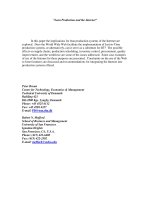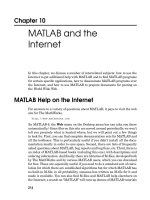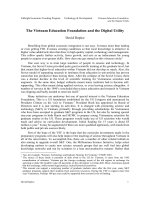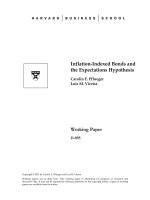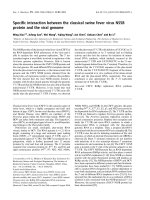Buy, Lie, and Sell High: How Investors Lost Out on Enron and the Internet Bubble pdf
Bạn đang xem bản rút gọn của tài liệu. Xem và tải ngay bản đầy đủ của tài liệu tại đây (1.99 MB, 248 trang )
I l@ve RuBoard
• Table of Contents
Buy, Lie, and Sell High: How Investors Lost Out on Enron and the
Internet Bubble
By D. Quinn Mills
Publisher : Financial Times Prentice Hall
Pub Date : June 19, 2002
ISBN : 0-13-009113-8
Pages : 288
In Buy, Lie, and Sell High, Harvard Business School Professor Daniel Quinn Mills offers the first systematic analysis
of both the Internet stock bubble and the Enron scandal. Drawing upon extensive new research and insider interviews,
Mills uncovers both systemic causes and outrageous misbehavior. He demonstrates how each link in the "financial
value chain" failed, from venture funds to auditors and regulators. Finally, he offers practical guidance for investors and
policymakers seeking to avoid the "next" speculative disaster.
I l@ve RuBoard
This document is created with the unregistered version of CHM2PDF Pilot
I l@ve RuBoard
• Table of Contents
Buy, Lie, and Sell High: How Investors Lost Out on Enron and the
Internet Bubble
By D. Quinn Mills
Publisher : Financial Times Prentice Hall
Pub Date : June 19, 2002
ISBN : 0-13-009113-8
Pages : 288
Copyright
Preface
FINANCIAL TIMES Prentice Hall
Financial Times Prentice Hall Books
Acknowledgments
Part I: The Bubble and Capital Markets
Chapter 1. How to Use This Book
Why This Book Has Been Written
How This Book Was Written
An Unusual Feature of This Book: Contributions from Others
The Message of This Book: How to Avoid Another Bubble and How to Protect Yourself
If It Occurs
Talking Points
Chapter 2. Destroyed by the Bubble
The Capital Markets as an Engine of Progress
The Social and Economic Utility of Capital Markets
The Internet, Capital Markets, and Innovation
The Early-Stage Financing of the Internet
The System Hits a Glitch
Talking Points
Part II: How the Bubble Happened
Chapter 3. Causing the Bubble
The Technology Bull Market
The Bubble
Why Did the Bubble Form?
Day Trading and the Source of the Bubble
Other Bubbles in History
The Software Cycle
This document is created with the unregistered version of CHM2PDF Pilot
The Transfer of Wealth
Talking Points
Chapter 4. Inflating the Bubble: the Financial Value Chain
The Financial Value Chain
Diagramming the Financial Value Chain
When Economic and Financial Value Diverge
Why the Huge Valuations for Internet Companies?
How the Financial Value Chain Should Have Worked
Defending Enormous Valuations
Talking Points
Chapter 5. What it Meant to "Do the Right Thing" at Enron
Enron as an Internet Company
Inflating the Enron Bubble
Wall Street's Involvement
The Key Role of the Accountants
Equity Analysts Promote the Company
Politicians Lend Their Aid
Evaporating Employee Pensions
Unethical, Unfair, but Illegal?
Enron's Significance
Talking Points
Part III: Inexperienced Leaders
Chapter 6. Dumb Kids?
Blaming the Entrepreneur—He's Dumb
Amazon.com's Miracle
How Amazon Flouted the Rules
The Learning Failure
Talking Points
Chapter 7. How Some VCs and Bankers Led Entrepreneurs in the Wrong Direction
Having to Go to the Venture Firms
Pressure to Spend
A Strategy's Limitations
Like Sheep to the Slaughter
Get-It-Right Instead of Get-Big-Fast
Talking Points
Part IV: How Venture Firms Changed Their Criteria
Chapter 8. Building to Flip
Venture Capital
Rushing to an IPO
Exiting an Investment
How Their Own Rules Were Changed by the Venture Capital Firms
The Baby Goes Out with the Bathwater
Talking Points
Chapter 9. Choosing the Wrong People
Whom to Back
Garden.com: A Mistake from the Get-go
Boo.com
Did the Venture Firms Make Money from the Bubble?
This document is created with the unregistered version of CHM2PDF Pilot
Talking Points
Part V: Taking Start-ups to the Public
Chapter 10. How Investment Banks Inflated the Bubble
The Banks Bend the Rules
The Investment Banks and Institutional Investors
Who Brought Those Duds to Market?
Mass Hysteria or Fraud
The Blame Game
Mass Hysteria
What Did the Venture Firms Know?
Did Wall Street Cross the Line?
If You Can't Sue City Hall, Can You Sue Wall Street?
Beware of "Buyer Beware"
Talking Points
Chapter 11. The Retail Investor: Victim or Fool?
The Buyers' Side of the Capital Market
Why Mutual Funds Got on the Bandwagon
Speculating with Pension Money
Momentum Investors in Disguise
Blaming the Investor—She's a Pig
How Important Is the Freedom to Speculate?
Talking Points
Chapter 12. Influencing Factors: Where Does Responsibility Lie?
What the Accountants Should Have Done and Didn't
The Hype Machine
The Fed Was Also at Fault
Talking Points
Part VI: The Road Kill of Capitalism
Chapter 13. Sell, Sell, Sell!
theglobe.com
Not a Smart Thing to Do
Young People Succeeding Early
The Return of Big Company Values
Talking Points
Chapter 14. Dire Consequences
Creating a New Business Cycle
Economic Losses Caused by the Bubbles
Starving Entrepreneurs of Capital
Setting Back Technological Innovation
What Happened in e-learning
Meanwhile, in Germany…
Another Wave of Internet Companies Is Coming
A List of the Economic Consequences of the Bubble
Insuring Public Confidence
Talking Points
Part VII: A Troubled System
Chapter 15. Can America Lead?
This document is created with the unregistered version of CHM2PDF Pilot
The United States as the World's Financial Leader
Should American Leadership Be Followed?
Dare We Privatize Social Security?
Why Current Regulation Isn't Working Well Enough
Talking Points
Chapter 16. Reforms to Protect Small Investors
The German Experience
Every Investor a Qualified Investor
Extending Fiduciary Responsibility
Improving Disclosure and Governance at Mutual Funds
A Return to a More Restrictive Prudent Person Rule
Preventing Another Enron
New Regulations to Protect Investors in IPOs
Nine Reforms to Restore Confidence and Rebuild the Economy
Talking Points
Part VIII: Less Damage Next Time
Chapter 17. What Does the Future Hold?
Do We Want Another Bubble?
Will There Be Another Bubble?
Smaller Bubbles and Less Damage
Appendix A. NEMAX (The German New Market) and NASDAQ
Appendix B. Financial Value Chain Influencers
Contributors
Notes
I l@ve RuBoard
This document is created with the unregistered version of CHM2PDF Pilot
I l@ve RuBoard
This document is created with the unregistered version of CHM2PDF Pilot
Copyright
Library of Congress Cataloging-in-Publication Data
A catalog record for this book can be obtained from the Library of Congress.
Credits
Editorial/Production Supervision: Carol Wheelan
Composition: Ronnie K. Bucci
Cover design director: Jerry Votta
Cover design: Talar Boorujy
Art director: Gail Cocker-Bogusz
Interior design: Meg VanArsdale
Manufacturing buyer: Maura Zaldivar
Executive editor: Jim Boyd
Editorial assistant: Allyson Kloss
Marketing manager: Bryan Gambrel
©2002 Pearson Education, Inc.
Publishing as Financial Times Prentice Hall
Upper Saddle River, New Jersey 07458
Financial Times Prentice Hall books are widely used by corporations and government agencies for training,
marketing, and resale.
For information regarding corporate and government bulk discounts please contact: Corporate and Government
Sales (800) 382-3419 or
Company and product names mentioned herein are the trademarks or registered trademarks of their respective
owners.
All rights reserved. No part of this book may be reproduced, in any form or by any means, without permission in
writing from the publisher.
Printed in the United States of America
10 9 8 7 6 5 4 3 2 1
Pearson Education LTD.
Pearson Education Australia PTY, Limited
Pearson Education Singapore, Pte. Ltd.
Pearson Education North Asia Ltd.
Pearson Education Canada, Ltd.
Pearson Educación de Mexico, S.A. de C.V.
Pearson Education—Japan
Pearson Education Malaysia, Pte. Ltd.
Dedication
To Betsy and Shirley
This document is created with the unregistered version of CHM2PDF Pilot
I l@ve RuBoard
This document is created with the unregistered version of CHM2PDF Pilot
I l@ve RuBoard
Preface
About Jonathan Lebed—a teenager who made money day trading on the Internet but ran afoul of Federal
regulations—Arthur Levitt, former Chairman of the Securities and Exchange Commission, is said to have commented,
"Put it this way, he'd buy, lie, and sell high."[1]
I l@ve RuBoard
This document is created with the unregistered version of CHM2PDF Pilot
I l@ve RuBoard
FINANCIAL TIMES Prentice Hall
In an increasingly competitive world, it is quality of thinking that gives an edge-an idea that opens new doors, a
technique that solves a problem, or an insight that simply helps make sense of it all.
We work with leading authors in the various arenas of business and finance to bring cutting-edge thinking and best
learning practice to a global market.
It is our goal to create world-class print publications and electronic products that give readers knowledge and
understanding which can then be applied, whether studying or at work.
To find out more about our business products, you can visit us at www.ft-ph.com
I l@ve RuBoard
This document is created with the unregistered version of CHM2PDF Pilot
I l@ve RuBoard
This document is created with the unregistered version of CHM2PDF Pilot
Financial Times Prentice Hall Books
For more information, please go to www.ft-ph.com
Dr. Judith M. Bardwick
Seeking the Calm in the Storm: Managing Chaos in Your Business Life
Thomas L. Barton, William G. Shenkir, and Paul L. Walker
Making Enterprise Risk Management Pay Off: How Leading Companies Implement Risk Management
Michael Basch
CustomerCulture: How FedEx and Other Great Companies Put the Customer First Every Day
J. Stewart Black and Hal B. Gregersen
Leading Strategic Change: Breaking Through the Brain Barrier
Deirdre Breakenridge
Cyberbranding: Brand Building in the Digital Economy
William C. Byham, Audrey B. Smith, and Matthew J. Paese
Grow Your Own Leaders: How to Identify, Develop, and Retain Leadership Talent
Jonathan Cagan and Craig M. Vogel
Creating Breakthrough Products: Innovation from Product Planning to Program Approval
Subir Chowdhury
The Talent Era: Achieving a High Return on Talent
Sherry Cooper
Ride the Wave: Taking Control in a Turbulent Financial Age
James W. Cortada
21st Century Business: Managing and Working in the New Digital Economy
James W. Cortada
Making the Information Society: Experience, Consequences, and Possibilities
Aswath Damodaran
The Dark Side of Valuation: Valuing Old Tech, New Tech, and New Economy Companies
Henry A. Davis and William W. Sihler
Financial Turnarounds: Preserving Enterprise Value
Sarv Devaraj and Rajiv Kohli
The IT Payoff: Measuring the Business Value of Information Technology Investments
Nicholas D. Evans
Business Agility: Strategies for Gaining Competitive Advantage through Mobile Business Solutions
Kenneth R. Ferris and Barbara S. Pécherot Petitt
Valuation: Avoiding the Winner's Curse
David Gladstone and Laura Gladstone
Venture Capital Handbook: An Entrepreneur's Guide to Raising Venture Capital, Revised and Updated
David R. Henderson
The Joy of Freedom: An Economist's Odyssey
Philip Jenks and Stephen Eckett, Editors
The Global-Investor Book of Investing Rules: Invaluable Advice from 150 Master Investors
Thomas Kern, Mary Cecelia Lacity, and Leslie P. Willcocks
Netsourcing: Renting Business Applications and Services Over a Network
Al Lieberman, with Patricia Esgate
The Entertainment Marketing Revolution: Bringing the Moguls, the Media, and the Magic to the World
Frederick C. Militello, Jr., and Michael D. Schwalberg
Leverage Competencies: What Financial Executives Need to Lead
D. Quinn Mills
Buy, Lie, and Sell High: How Investors Lost Out on Enron and the Internet Bubble
Dale Neef
E-procurement: From Strategy to Implementation
John R. Nofsinger
Investment Blunders (of the Rich and Famous)…And What You Can Learn From Them
John R. Nofsinger
Investment Madness: How Psychology Affects Your Investing… And What to Do About It
Tom Osenton
Customer Share Marketing: How the World's Great Marketers Unlock Profits from Customer Loyalty
W. Alan Randolph and Barry Z. Posner
Checkered Flag Projects: 10 Rules for Creating and Managing Projects that Win, Second Edition
Stephen P. Robbins
The Truth About Managing People And Nothing but the Truth
Fernando Robles, Françoise Simon, and Jerry Haar
Winning Strategies for the New Latin Markets
Jeff Saperstein and Daniel Rouach
Creating Regional Wealth in the Innovation Economy: Models, Perspectives, and Best Practices
Eric G. Stephan and Wayne R. Pace
Powerful Leadership: How to Unleash the Potential in Others and Simplify Your Own Life
Jonathan Wight
Saving Adam Smith: A Tale of Wealth, Transformation, and Virtue
Yoram J. Wind and Vijay Mahajan, with Robert Gunther
Convergence Marketing: Strategies for Reaching the New Hybrid Consumer
This document is created with the unregistered version of CHM2PDF Pilot
I l@ve RuBoard
This document is created with the unregistered version of CHM2PDF Pilot
I l@ve RuBoard
Acknowledgments
I am deeply indebted to several people for assistance on this book. Most importantly, I owe much to the small team
that helped me do the research and design of the book: Kirstin Hornby, Dr. Dirk Seifert, and Mark Cicerelli.
Many of my colleagues on the faculty of the Harvard Business School were very generous in their responses to my
inquiries about the bubble and its consequences, including Joseph Bower, Thomas Eisenmann, Paul Gompers, Samuel
Hayes, Josh Lerner, Jay Light, Robert Merton, Krishna Palepu, William Sahlman, Howard Stevenson, Peter Tufano,
and Michael Yoshino. I also benefited from the kind help of several of our students, including Gad Caspy, Mark
Cicerelli, Kevin Greene, and Daniel Hawkins. I am indebted as well to our Dean, Kim Clark, and to John Dunlop,
University Professor at Harvard, for their generosity in reviewing a draft of this book.
I appreciate the assistance of the following in this study: Gilbert Butler, Kim Davis, Ted Dintersmith, Robert R.
Glauber, Torrence Harder, Samuel L. Hayes III, Karl Jacob, Edward C. Johnson III, Arthur Levitt III, Phil Lochner,
John Maxwell, Andrew G. Mills, Shirley Mills, Reiner Neumann, Steve Papa, Norbert Reichert, Steven Rosefielde,
John Stanton, and Martin Wansleben.
I am grateful to the Harvard Business School Division of Research for its support of my work.
All interpretations and any errors are my responsibility alone.
Daniel Quinn Mills
Boston, Mass.
May 2, 2002
I l@ve RuBoard
This document is created with the unregistered version of CHM2PDF Pilot
I l@ve RuBoard
Part I: The Bubble and Capital
Markets
The great Internet bubble in the stock market burst in the spring of 2000, but the repercussions of the mania continue.
Even today, companies that have held on since the bubble are finally collapsing. Far from the bubble being gone, it
and its consequences are with us still.
I l@ve RuBoard
This document is created with the unregistered version of CHM2PDF Pilot
I l@ve RuBoard
Chapter 1. How to Use This Book
Why This Book Has Been Written
How This Book Was Written
An Unusual Feature of This Book: Contributions from Others
The Message of This Book: How to Avoid Another Bubble and How to Protect Yourself If It Occurs
Talking Points
I l@ve RuBoard
This document is created with the unregistered version of CHM2PDF Pilot
I l@ve RuBoard
Why This Book Has Been Written
I've written this book because of what happened to a friend of mine. She was in her 50s, and had painfully
accumulated over her working life a nest egg. When she lost her job, she received the money in a lump sum. It was to
help support her old age. She visited the Web site of one of the largest mutual fund companies and studied the
performance record of the 15 or so funds they offered for annuity contracts. She identified those with the best returns.
She then called a representative at the company to ask about an investment. He told her that she had picked the two
best funds, just what she should do, and he arranged for her to make the investment. She now had an annuity contract
with the mutual fund company with her capital invested in a single fund.
Three months later the fund began a rapid collapse. She called the company and was told that the decline was
temporary, and that the proper long-term strategy was to remain invested. She did, and the fund fell to about 30
percent of its level at which she had bought it. It turned out that the fund had been heavily invested in Internet stocks.
"Why did I lose my money?" she asked me. "Why was my pension money invested in such speculative stocks? Who
got the money I lost?"
I l@ve RuBoard
This document is created with the unregistered version of CHM2PDF Pilot
I l@ve RuBoard
How This Book Was Written
So a small team and I went to work studying the great Internet bubble. We looked at the various players who were
involved in the process by which venture funds and entrepreneurs built companies, and then with the investment
banks, took them public. We made a list of how the venture funds changed their investment criteria as the bubble
developed, and how investment banks changed their criteria for taking firms public. We looked at how the mutual
funds shifted their investment criteria so that many funds became loaded with dot-com and telecom stocks. We
looked at Alan Greenspan's warnings, and at the inflation and then bursting of the bubble. We looked at who made
money in the outcome, and who lost.
We have read the literature on financial manias and explored the explanations being given for the recent bubble. The
key explanations are that (1) it was an accident: A group of forces came together like the perfect storm—new
technology, an affluent investing public, and a booming economy—and then blew themselves out; (2) it was
engineered: The incentive structures in financial service firms made their blowing up into a bubble a certainty; (3) it
was a result of inexperience: Investment professionals (including the business press) were young and inexperienced,
and believed that the New Economy was qualitatively different from the Old Economy so that valuations weren't
recognized as inflated; and (4) it was another example of the madness of crowds—individual investors were prone to
mass hysteria and didn't do their homework and so drove stock prices to unreasonable levels, and when the bubble
burst, got what they deserved.
We also asked whether or not the entrepreneurs, venture firms, investment banks, brokerages, and mutual funds
really thought that the companies they sold the retail investor were legitimate firms; and we looked at the litigation now
underway about how IPO sales were conducted.
We asked whether or not a bubble was a necessary consequence of the operation of our free markets—the way
western economies raise capital to fund technological innovation? Or, alternatively, whether the bubble was a
dangerous aberration that should be avoided if possible?
Our research convinces us it is the latter, so we asked what might prevent another bubble, or at least help protect
retail investors from the worst ravages of one if it occurs.
We also looked at Germany, which had a somewhat similar bubble in Internet stocks, but with a very different
outcome for small investors, and asked why. In this book, several times we provide German examples of what
happened in the Internet bubble; they provide important supplementary material showing how the bubble leapt
international boundaries, and how its elements were often the same but sometimes different. But in this book, to avoid
confusion we usually are talking about the American experience, except where Germany is explicitly cited.
We were fortunate to find many knowledgeable people willing to talk with us about the bubble. Some were willing to
do so for attribution; others were unwilling to let themselves be identified, in part because litigation about events during
the bubble is gathering force today, and many people are either involved in or hoping to stay out of the legal fray.
Regardless of whether or not people were willing to be identified in print, they provided us with an ongoing dialogue
from which this book emerged. It's the hope of our research team that readers will engage their own friends and
acquaintances in a discussion of the important issues which arise in this book. To encourage such a dialogue, we have
provided a small group of talking points at the end of each chapter—not a summary of the chapter, but rather the key
points that a person might want to take from it to a discussion with others.
I l@ve RuBoard
This document is created with the unregistered version of CHM2PDF Pilot
I l@ve RuBoard
An Unusual Feature of This Book: Contributions from Others
An unusual feature of this book is that it includes short contributions from people other than the author and his team.
Several American and German participants in the bubble have consented to give their experiences and their views
about the issues with which this book is concerned, so that this book provides a forum within which some of the
players in the Financial Value Chain can discuss what occurred during the bubble. Sometimes contributors to this
book don't agree with the author, but differences in opinion will help the reader make up his or her own mind about
what happened in the Internet financial mania and what it means for each of us.
I l@ve RuBoard
This document is created with the unregistered version of CHM2PDF Pilot
I l@ve RuBoard
The Message of This Book: How to Avoid Another Bubble and How
to Protect Yourself If It Occurs
From our inquiry, we've developed a set of suggestions as noted in Chapter 16, "Reforms to Protect Small
Investors," about how entrepreneurs and investors can help avoid another bubble or protect themselves from it if it
occurs, including proposed regulatory reforms that would provide much more protection for investors in the event of
another bubble.
I l@ve RuBoard
This document is created with the unregistered version of CHM2PDF Pilot
I l@ve RuBoard
Talking Points
Many investors took heavy losses during the Internet bubble. How did that happen and what, if anything, should be
done about it?
I l@ve RuBoard
This document is created with the unregistered version of CHM2PDF Pilot
I l@ve RuBoard
This document is created with the unregistered version of CHM2PDF Pilot
Chapter 2. Destroyed by the Bubble
The room was full of people, some of whom controlled large amounts of investors' money. David Perry stood
nervously as he prepared to step to the front and address the group during the Harvard Business School new business
competition. It was for this that he had come to the Harvard Business School, but he could not escape misgivings.
What if he bombed? Still, he'd prepared well, and as the final seconds sped by before it was his turn to present,
excitement at the prospect before him pushed aside other emotions.
Perry stepped to the front of the room, wiped a bead of sweat from his forehead, and began, "I'd like to introduce a
new concept to you. I call the company Chemdex." He went on to discuss a new forum for B2B exchange in the
life-science and medical equipment industries. B2B had never been done before, but it was quite impressive to the
professors. In fact, it won second place in the contest. And this was good enough for Kleiner Perkins Caufield and
Byers, who became the lead investor in Chemdex, and the first VC firm to fund a company of this nature.
With two million dollars of seed money in his pocket, a lot of courage in his heart, and a few weeks of life in the "real
world" post-Harvard Business School, in June 1997, Perry hopped into his car, sped out to the West coast, and
started Chemdex. Perry began the company in September 1997, with co-founder Jeff Leane (who left the company in
late 1999), and launched the Web site in 1998. Perry was thrilled to secure about $13 million in VC funding from
Kleiner Perkins Caufield and Byers, along with CMGI and Bay City Capital, by May 1998, and an additional $30
million by April 1999.[2]
At this point, Perry was encouraged to build the business quickly and to proceed to the IPO, whether or not he was
ready. Perry was again nervous, and remembered the day of his presentation. But all had gone well so far, and thus,
nine months after the launch, in July 1999, Perry turned over the financial reports of the company to Morgan Stanley,
BankBoston, Robertson Stephens, and Volpe Brown Whelan & Company, LLC to execute the IPO with a
suggested per share price of $15.
It turned out he had no need to worry. Less than one year later, in June 2000, his stock was up 1,620 percent, to
$243.50 per share. This was a bit overwhelming for Perry. He was out of business school for three years, and, at age
32, found himself almost a billionaire. But Perry wasn't worried about saving for a rainy day. He had a lot of faith in
his idea, and was going to push it until it burst. He reinvested all that he received into the company.
In February 2000, when the company changed its name to Ventro, Perry held an enormous party for his employees,
featuring himself lip-syncing in a rock video. He also bought a jet. He was a bit concerned that stock analysts at the
Wall Street firms might look askance at a young CEO with a company that as yet had virtually no sales, not to
mention any profits, spending this way, but he needn't have worried. The analysts had no problem with his actions.
Mary Meeker, Morgan Stanley's Internet stock wizard, predicted that Ventro would have revenues of $129 million in
2000. So Perry saw no reason to sell any of his stock. To top it all off, in June 2000, he was named northern
California's—and thereby Silicon Valley's—entrepreneur of the year.
Perry continued to grow his company, purchasing and building four new online marketplaces. He used his company's
soaring stock to buy Promedix, an online marketplace for specialty medical supplies. He hired a staff of highly
regarded executives, including Robin Abrams, president of Palm Inc., as his COO.
Though Perry was delighted with the growth of his stock and his business, he had a few misgivings. Building
marketplaces was expensive, about $45 million for the first one, and about $7 million for the second, and for some
reason, the revenue numbers just were not coming in as he, and Wall Street's analysts, had predicted. With the
company's continued expansion, encouraged by the high stock prices, Perry began to realize that things may not be as
rosy as he had expected. By the second quarter of 2000, Chemdex only had 144 corporate customers, and was
generating considerably less revenue than Wall Street was forecasting. Perry tried to figure why the revenue numbers
were so low. Potential customers simply were not buying. Later reporters would write that "Analysts said Perry's B2B
dreams have collapsed largely because of a flaw in his business plan. Ventro 'attempted to get between the suppliers
and buyers of mainstream products,' said John Bermudez, analyst with AMR Research, which studies online business
markets. 'Suppliers don't really want anyone between them and their customers.'"[3]
Further, though Perry knew his company's costs were enormous, he had not paid much attention because none of his
venture capital backers, upon whom he relied for business direction, had expressed concern about costs. But with his
firm's rapid expansion and high costs, losses started to get so out of control that Ventro's board of directors, against
Perry's wishes, ordered a search for a buyer for Ventro. To Perry's dismay, by the end of 2000, Ventro closed down
the original Chemdex chemical marketplace. By now the company had lost almost $618 million, and soon after, it lost
most of its top executives. Then he had to do what to him was almost unthinkable—cut his staff in half. Perry saw his
dreams dissolve. In June 2001, matters got worse when Ventro faced a shareholder lawsuit filed in federal court in
San Francisco alleging securities fraud by Ventro executives. It had been two years since he'd taken the company
public, and three years since he had founded it. The collapse of Ventro's stock price can be seen in Figure 2-1.
Figure 2-1. Ventro stock price, 7/29/99–12/7/01.
How did this happen? How was Ventro allowed to raise all this money, only to see it disappear? Did Perry lack
experienced advisors? It wouldn't seem so. Brook Byers, who is the managing director at Kleiner Perkins Caufield
and Byers, one of our nation's most experienced and successful venture capital firms, served as a director on Ventro's
board, and as its chairman. Jon Callaghan has served on the board for years while a general partner at CMGI
Ventures.
Today Ventro is holding on despite the fact that its stock is now listed at about $.30 per share. Perry himself,
however, has been left in a most serious situation. Near the height of the company's share price he had exercised
some options, buying shares of his company's stock at a price much lower than the price in the public market.
Expecting the stock to go higher, Perry did not sell the shares but put them in his personal portfolio. When the stock
price started to fall, he held on to his shares to demonstrate his confidence in its ultimate rebound to his investors. But
by a quirk of American tax law, the Internal Revenue Service assessed him a tax on the difference between what he'd
paid for the shares and their price in the public market on the day he'd purchased them (a so-called phantom gain).
The amount of his tax liability was some $50 million—although he had never received a penny by selling any of the
shares he'd purchased. Nor was there any escape for him via personal bankruptcy—bankruptcy does not discharge a
debt to IRS.
Ventro struggles along today, still losing money and abandoned by its erstwhile supporters on Wall Street. A
company that had in February 2000 been valued by investors at some $8 billion, was worth only a few million little
more than a year later. A young entrepreneur who had been in February 2000 a very wealthy man was, a year later,
so far in debt to Uncle Sam that never again could he reasonably hope to have any financial security.
Young entrepreneurs are not unique to America, nor is it only in America that they were able in recent years to obtain
financing for their business ideas. Peter Kabel was 22 years old, a student at Hamburg University and a ticket seller at
a motion picture theatre when he started his first venture, a graphic design company. Several years later, when he was
29 and had finished his studies, Kabel founded Kabel New Media, describing it as a full service e-business enabler.
In March, 1998 KNM began operating a professional tennis tour Web site, taking responsibility for obtaining
advertising revenues, and thus becoming a multimedia advertising agency. This became the basis of a story about
potential sales and profits which strongly stimulated the imagination of the financial markets and future investors. A
handsome, dark-haired young man, Kabel quickly became a favorite of brokers and investors in Germany.
On June 15, 1999, shares in KNM were sold ("floated") to the public on the new market segment of the Frankfurt
Stock Exchange, underwritten by two major banks: BNP Paribas and DG Bank. The share price peaked within six
months at more than 13 times the IPO price. The company attracted several significant corporate clients. At its peak,
more than 800 people were employed by KNM. Meanwhile, Kabel decided that the title "Professor" would enhance
his reputation, and became a part-time professor at the College of Media Design in Hamburg.
Soon, however, financial results were disappointing, especially compared to the high valuation of the company.
Beginning in March 2000, the company's share price entered a precipitous decline. Shortly, KNM announced a
cessation of payments, essentially insolvency, and by August 2001, Peter Kabel left his position as CEO. On that
same day prosecutors began an investigation of Kabel, because up to two weeks before the company declared
insolvency he had been assuring investors that it would reach break-even at the end of 2001. Soon thereafter, Paribas
ceased to sponsor the stock of the company. (See Table 2-1).
Table 2-1. Timeline for Kabel New Media.
Year Events
1986 Founding of Peter Kabel's first company: Buero fuer
grafische Gestaltung.
1991 Founding of two additional companies: Kabel Hamburg
and Buero Hamburg.
1993 End of Kabel's studies and founding of Kabel New
Media.
June 15, 1999 KNM goes public on the Frankfurt stock exchange
(price: 6.15 Euro).
July 1999 First takeover of competitor "Cutup codes."
March 2000 KNM reaches share price peak: over 80 Euro (worth:
1.3 billion Euro).
March 1, 2000 Acquisition of the Team4 (CRM specialist).
May 11, 2000 Acquisition of the Austrian IT consultant Scope.
May 16, 2000 Acquisition of the Swedish IT consultant Lexor.
May 24, 2000 Peter Kabel voted entrepreneur of the year 2000.
June 28, 2001 Temporary cessation of payment.
August 1, 2001 KNM's CFO and deputy chairman steps back.
August 28, 2001 KNM sells subsidiary in Vienna.
August 31, 2001 Peter Kabel announces his resignation.
August 31, 2001 Prosecutors start their investigations.
September 1, 2001 Insolvency proceedings for KNM formally commenced.
September 4, 2001 BNP Paribas announces its withdrawal from its position
as designated sponsor of KNM.
November 2, 2001 The German stock exchange excludes KNM from the
market (last price: 0.08 Euro).
Over the short period from June 1999 to September 2001, some $1.2 billion (the March 2000 value of the company
on the Frankfurt exchange) of value had been created and had then disappeared.
It had taken about 18 months from its inception for KNM to become a publicly listed company. It had taken nine
months for the company to reach a billion dollar valuation, and then it had taken 15 months for the company to
become valueless. A promising entrepreneurial venture which, given a decade, might have become a major company,
had instead been caught up in a financial bubble. The bubble first wildly exaggerated the company's value, inducing the
firm's leaders to expand far too rapidly, and then, like a balloon when the nozzle was suddenly released, quickly
deflated, causing employees at the company to lose their jobs and the investors their money.
This document is created with the unregistered version of CHM2PDF Pilot
I l@ve RuBoard
This document is created with the unregistered version of CHM2PDF Pilot
